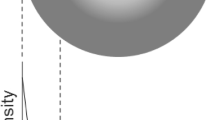Abstract
An efficient finite-element procedure has been developed for the analysis of induction heat treatment problems involving nonisothermal phase changes. The finite-element procedure first simulates the magnetic field developed when currents flow through an induction coil by solving Maxwell’s electromagnetic field equations; at the following step, it calculates the temperature distribution in the workpiece due to eddy currents induced by the magnetic field. The final stage of the simulation involves the determination of the distributions of residual stress, hardness, and microstructure in the workpiece. The finite-element analysis includes temperature-dependent material properties, changes in permeability of the workpiece at the Curie temperature, a mixed hardening rule to describe the material constitutive model, and the incorporation of time-temperature-transformation (TTT) diagram. The procedure was applied to the simulation of the induction hardening of 1080 steel bar. Firstly, the magnetic field and temperatures developed in the workpiece during (a) the induction heating of an infinitely long 1080 steel cylinder by a single encircling coil and (b) the induction heating of a semi-infinite half-space by a single coil suspended above it were calculated using the finite-element procedures. These were validated by comparing them with analytical solutions derived for these configurations using a Green’s function method. Finally, to demonstrate the predictive capability and practical applicability of the current finite-element procedure, two examples pertaining to the induction heat treatment of an infinite 1080 steel bar of square cross section and a notched finite 1080 steel cylinder of circular cross section were analyzed to predict the magnetic field, temperature, and residual stress distributions. The current finite-element procedure could be used as a powerful design tool for linking induction heat treating parameters with the mechanical property attributes of the heat treated component.
Similar content being viewed by others
References
J. Davies and P. Simpson,Induction Heating Handbook, McGraw-Hill, London (1979).
C.V. Dodd and W.E. Deeds, Analytical Solution to Eddy-current Probe Coil Problems, Report ORNL-TM-1987 (1967).
C.V. Dodd, Solutions to Electromagnetic Induction Problems, Report ORNL-TM-1842 (1967).
J. Donea, S. Giuliani, and A. Philippe, Finite Elements in the Solution of Electromagnetic Induction Problems,Int. J. Num. Meth. Eng., 8,359–367 (1974).
M.V.K. Chari, Finite-Element Solution of the Eddy-current Problem in Magnetic Structures,IEEE Trans. PAS-93(1), 62 (1973).
G. Meunier, D. Shen, and J. Coulomb, Modelisation of 2D and Axisymmetric Magnetodynamic Domain by the Finite ElementMethod, IEEE Trans. Magnetics, 24(1), 166–169(1988).
R.M. Baker,Classical Heat Flow Problems Applied to Induction Billet Heating,AIEETrans., 77, 106–112, May (1958).
Ph. Massé, B. Morel, and Th. Breville, A Finite Element Prediction Correction Scheme for Magneto-thermal Coupled Problem during Curie Transition,IEEE Trans. Magnetics, 21(5), 1871–1873(1985).
M. Melander, Theoretical and Experimental Study of Stationary and Progressive Induction Hardening,J. Heat Treat., 4, 145–166 (1985).
J.D. Lavers, Numerical Solution Methods for Electroheat Problems,IEEE Trans. Magnetics, 19(6), 2566–2572 (1983).
A.J. Fletcher,Thermal Stress and Strain Generation in Heat Treatment, Elsevier Science, London and New York (1989).
K.F. Wang, S. Chandrasekar, and H.T.Y. Yang, An Efficient 2D Finite Element Procedure for the Quenching Analysis with Phase Change,ASME J. Eng. Ind., (1992).
R.P. Feynman, R.B. Leighton, and G. Sands,The Feynman Lectures on Physics, vol 2, Addison Wesley, New York (1962).
M. Avrami, Kinetics of Phase Change I,J. Chem. Phys., 7, 1103 (1939).
M. Avrami.Kinetics of Phase Change II,J. Chem. Phys., 8, 212 (1940).
P.K. Agarwal and J.K. Brimacombe, Mathematical Model of Heat Flow and Austenite-Pearlite Transformation in Eutectoid Carbon Steel Rods for Wire.Met. Trans. B, 12, 121–133 (1981).
F.M.B. Fernandes, S. Denis, and A. Simon,Mathematical Model Coupling Phase Transformation and Temperature Evolution during Quenching of Steels,Mater. Sci. Technol., 1, 838–844 (1985).
D.P. Koistinen and R.E. Marburger, A General Equation Prescribing the Extent of the Austenite-Martensite Transformation in Pure Iron-Carbon Alloys and Carbon Steels,Acta Metall., 7, 59 (1959).
S. Denis, S. Sjöstrom, and A. Simon, Coupled Temperature, Stress, Phase Transformation Calculation Model Numerical Illustration of the Internal Stresses Evolution During Cooling of a Eutectoid Carbon Steel Cylinder,Met. Trans. A, 18, 1203–1212 (1987).
P.D. Harvey,Engineering Properties of Steel, ASM, Materials Park (1982).
M.N. Özisik,Heat Conduction, John Wiley & Sons, New York (1980).
Author information
Authors and Affiliations
Rights and permissions
About this article
Cite this article
Wang, K.F., Chandrasekar, S. & Yang, H.T.Y. Finite-element simulation of induction heat treatment. JMEP 1, 97–112 (1992). https://doi.org/10.1007/BF02650041
Issue Date:
DOI: https://doi.org/10.1007/BF02650041




